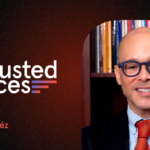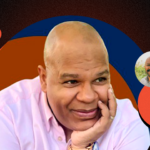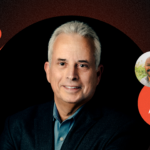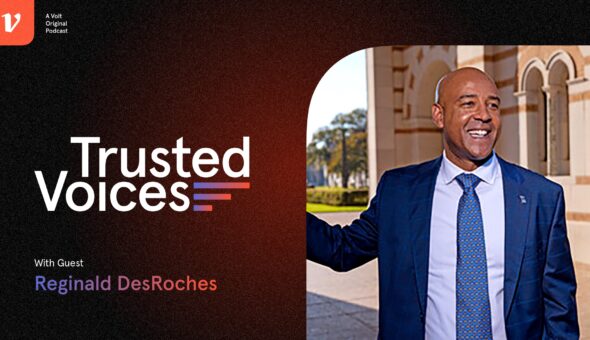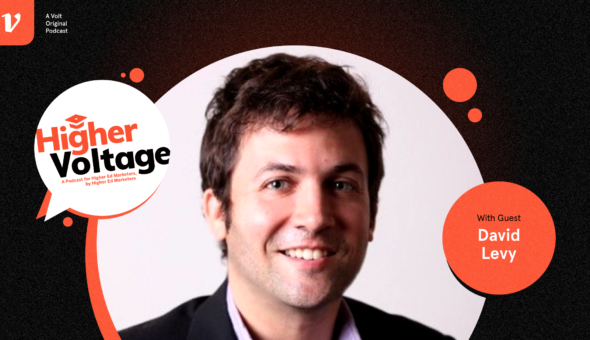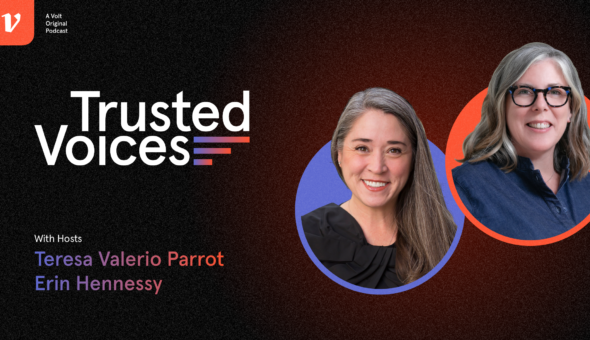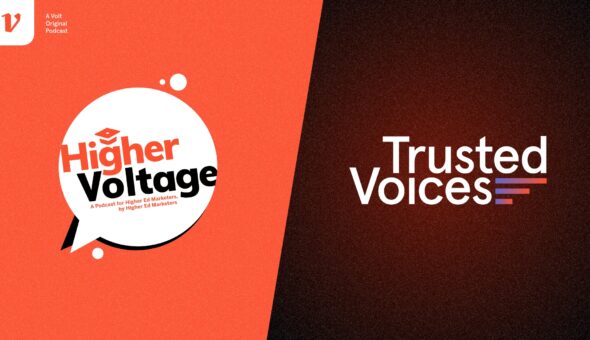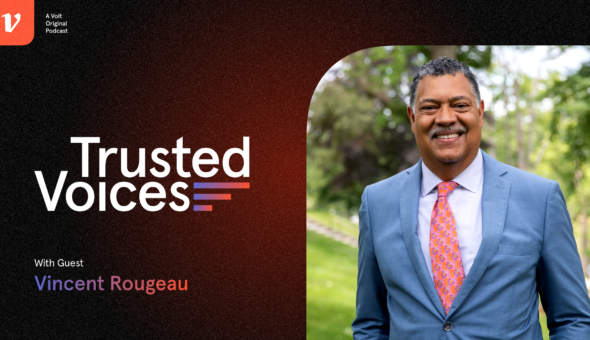Teresa and Erin are back to recap their conversation with Eric Hoover, senior writer at The Chronicle of Higher Education. Along the way, they discuss the idea of—and challenges to—a collective marketing campaign to promote the value of a higher education; the nuances surrounding test-optional admissions policies; and what fully transparent admissions counseling for prospective students could look like.
Read the complete transcript
Teresa Valerio Parrot:
Hello and welcome to part two of the Trusted Voices Podcast. I’m Teresa Valerio Parrot alongside Erin Hennessy. After each episode, we take some time together to digest our conversation with our most recent guest, and then we also talk about what we’ve learned, what we’d like to learn more about and resources we’ve found helpful in thinking about these topics. If you haven’t had a chance to listen to our conversation yet, I encourage you to scroll back in your feed and hit play.
Erin Hennessy:
In part one of this episode, we talked with Eric Hoover of the Chronicle of Higher Education about admissions, rankings, institutions going test optional and how institutions do and should market to students and families. Teresa, it’s been a couple of days since that chat. What has stuck with you?
Teresa Valerio Parrot:
I’m still really thinking about one of the early conversations we had where we were talking about the idea of collectively marketing higher education or maybe not. And I do think as we started that first question, that this does feel like the perfect storm in the industry. And of course we’ve talked about that many times. You and I talk about it all the time. And so maybe the timing is right for collaboration. But I do think that there is something that’s so important as we talk about a collective campaign. And that is that I don’t know that any collective effort can really approach higher education as a monolithic industry and can still have institutions see themselves within the description of the value and the benefits of higher education.
And I also think that these combined campaigns for all of higher education, they really run counter to what it is that we task marketers and communicators with doing. We’re asking for institutions and leaders to be part of a collective effort to rebuild public trust in higher education and reclaim the value of a degree. But that usually runs counter to how we’re also asking marketers and communicators to differentiate their institutions. And these combined campaigns may put them in some very difficult and dicey spots with the collective versus the individual.
Erin Hennessy:
Yeah. And it’s interesting, since our conversation with Eric, I’ve had two or three additional conversations about these sort of collective marketing efforts. And what I’ve come to really wrestle with is the fact that a lot of these efforts, I think in an attempt to be as broad-based and inclusive as possible and not having the resources or the time or the ability to really segment out the audiences or the institutions, a lot of these campaigns feel, to me, like they are responding to that age old trope that again, you and I talk about all the time, that the trust gap in higher ed is a storytelling issue. And when we ask people to submit press releases and stories about good things institutions are doing, that’s great and it’s important, and I don’t mean to denigrate that work at all. But I do wonder what a campaign looks like that pushes beyond the storytelling approach and really gets into data, gets into how higher education is being responsive.
I mean, we all sort of talk about higher education needs to be more innovative, but what does that mean? What does that look like? And to your point, I don’t think we can talk about that in this sort of big generalized way. I think we need to drill down and say what does it look like for community colleges in Indiana to be responsive and innovative? What does it look like for regional public institutions in the upper Midwest to be innovative and responsive? And just to your point, it’s great to think about the good old days of the ad council campaigns and the big pushes around go to college, college is possible and all of those things. But I think we have moved beyond those kinds of efforts in terms of how deep this trust hole is already and how hard we’re going to have to work to get back some of that public trust and what it’s going to take to actually do that.
Teresa Valerio Parrot:
Yeah. And I worry about the necessity of broadening out how we talk about ourselves so that we lose the hallmarks of what make higher education in the United States something that is so different and is so valuable. If you look at some of these efforts and who has signed on already, it’s kind of the usual suspects, already successful and already well-known types of institutions. And I think the reality is that a number of institutions that would like to see themselves included and are really the backbone of how higher education works in this country, as you mentioned, the community colleges and the regional comprehensives, they may not have the money or the time to participate, which means others get to talk about them. And that always makes me nervous. But I know you also had some takeaways from the episode. And I’m curious what else really struck a chord with you.
Erin Hennessy:
Yeah, I was really interested in how Eric really provided a layer of nuance around the test optional conversation. I think a lot of people, myself included, as was evidenced by sort of how I structured that question, feel like the test optional conversation is one that resonates for elite and highly selective institutions and the students who are more than likely bound for those institutions when they finish high school. He really made me think to think about this in a very different way and think about how far reaching these policies are beyond just wealthier students from wealthier communities who are looking at those highly selective and elite institutions. But how these testing policies reach into the lives of so many students for admission, but also for scholarship consideration and for a number of other things, and the stress that they cause for all of those students, not just the certain subset that I was presuming were most impacted by these policies.
Teresa Valerio Parrot:
I think he did a fantastic job of bringing the humanity of this process back into focus. And his writing does that as well. And I also think he gives me the ability to push back a little bit on something that you said earlier and that you say quite often, and I agree with you 99% of the time. But sometimes we do have a storytelling problem. And I think that in this case, he’s giving an example of that. And I wouldn’t say it’s not a storytelling problem by marketers and communicators. I think it’s instead getting leaders to a place where they are willing to listen to how students, counselors, and parents describe their needs rather than us assuming what they need. And we assume we know how to go about it. So in some cases, it may be a storytelling problem. And that may require a president to listen to their marcom team. Or as Eric noted, to let go of the wheel a bit. And there’s something really important about letting go.
Erin Hennessy:
Yeah, and I think you’re absolutely right, and it comes back to that question of segmentation again. Obviously it’s so hard to communicate to prospective students because you aren’t communicating to prospective students. You are communicating to a number of different segments, a number of different kind of students. And you’re absolutely right. Stopping and thinking, what does this group need to hear? What would resonate with this group? What are the questions or concerns or obstacles or fears that this group is likely to have? And how does that differ from is really what our presidents need to do and our enrollment management teams need to do and our alumni teams need to do. It’s really easy to echo Eric. It’s really easy for us to say that because we’re not sitting in the chair day in, day out dealing with the financial pressures, the administrative pressures, the steady drumbeat of what needs to get done to get through commencement or convocation or whatever the event of the week is.
And I think you’re absolutely right. If there was one thing we said most often to clients, it would be encouraging them to lean in a bit more toward vulnerable. We would never want to put an institutional leader, anybody in a place where they were too vulnerable. But I think there’s so much to discuss around that idea, but being vulnerable and also, and I was pleased to hear Eric mention it, being willing to not just admit students, but to counsel them, to say, “This is a fit for you, or this isn’t a fit for you. And that doesn’t mean you’re a bad student or they’re other better students, just means this might not be the right place.” So they are all such nuanced conversations, and there are so many reasons why I was not suited for long-term work in the enrollment management field. And I’m just in awe of the people who make this their life and commit to doing well by our students this way.
Teresa Valerio Parrot:
Right. I’m going to just share a phrase that I like to use with a number of senior leaders, and that is that we will always encourage our leaders to have an appropriate amount of vulnerability. That’s different than being vulnerable writ large, but instead allows us to structure that so that they are letting go, but they’re letting go in a way that is responsible and is also responsive to what the moment needs. So I think one place where I saw a little bit of vulnerability come up in our conversation, and I want to give Eric a credit for this, is that he reflected on his past experiences and behavior with media relations professionals in ways that I appreciated. You and I both have been blasted by reporters. And I’ve wondered in the past if they’ve] even realized what that feels like and that there are people behind either what they tweet or they say or they email back, whatever it might be. And I was pleased to hear he’s thought about how that must feel and has changed some of his behaviors as a result.
Erin Hennessy:
Yeah. I agree with you, and I think it’s always going to be a relationship with a little bit of tension in there. But I think his point about empathy is a good one. And it is hard to remember when you see a reporter dragging a PR professional’s pitch on Twitter. But building empathy into that relationship and remembering that it is a relationship, which means it is built over time and it doesn’t exist the minute your pitch hits an inbox. But it depends on research and being a resource and all of the things that young media professionals hear early on. They’re all true. And we all need to keep those things in mind. And I think if we can carry empathy into all of our professional relationships this year, we’ll all be better for it.
And on that uncharacteristically optimistic note, we’re going to wrap up episode two. Thanks again for joining us on Trusted Voices. We’ll look forward to being back in your feed in a couple of weeks with a new guest and continuing conversation about higher education, leadership and communications. Until then, on behalf of Teresa, our thanks to DJ Hauschild, Aaron Stern and the Volt team for another great episode. Bye, Teresa.
Teresa Valerio Parrot:
Bye-bye.
